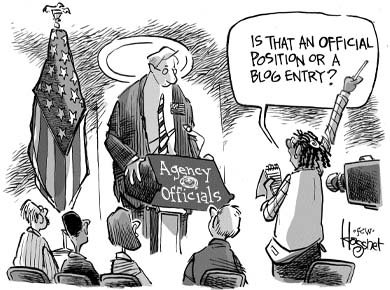Editorial: Defending CIO bloggers
The role of the CIO is to stay ahead of the train and guide the track.
We have been proponents of the new crop of collaboration tools, which are collectively referred to as Web 2.0. We believe these tools offer the government an opportunity to improve information sharing — an important but difficult task for agencies. There are concerns about the use of Web 2.0 tools, and we want this publication and our Web site to be a platform to debate those concerns. In recent weeks, on FCW.com’s FCW Forum blog, there has been a lively exchange about some of the issues. Some of the comments are so valuable that we offer them in the following pages.For example, participants asked several questions about the growing number of agency officials, including chief information officers, who are writing public blogs. Are these blog posts official or unofficial? Do Cabinet secretaries, CIOs or other executives write from their position as government officials? Or are they representing only their own opinions?There are many issues emerging with the development of Web 2.0 collaboration tools. The security and privacy questions are the most significant.Throughout this debate, we believe it is important to hold the same expectations for new technologies that we do for current practices. For example, CIOs and other government officials often speak at various events about their views on how an agency should do business. At those events, there can be hundreds of people in the audience, but no one raises red flags about whether a CIO is speaking officially or unofficially. We know those presentations are an essential part of leadership. CIOs’ blog entries should be viewed in much the same way. We have praised the handful of CIOs who have tested the Web 2.0 waters, including the CIO bloggers. Those blogs, like many other collaborative technologies, offer unique ways to lead. Linda Cureton, CIO at NASA’s Goddard Space Flight Center, who recently launched her own blog, said the role of the CIO is increasingly to help guide an agency through change and figure out how technological advances can help an agency accomplish its mission. To borrow her analogy, the train is coming down the track at an ever faster speed. The role of the CIO is to stay ahead of the train and guide the track.Many of the concerns about collaboration tools are management issues. And, frankly, they are similar to those we confronted when employees got e-mail accounts and, earlier, telephones. Do we throw out the productivity gains that have come from e-mail because some people misuse that tool?Finally, we don’t believe Web 2.0 collaboration tools will replace any of the existing processes. Instead, they will enhance them.We love the ongoing debate. We think it is important to flesh out these issues. No tool is perfect, but too often, there is an assumption that the processes agencies use now are perfect. And we know that they aren’t.







